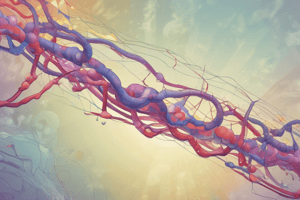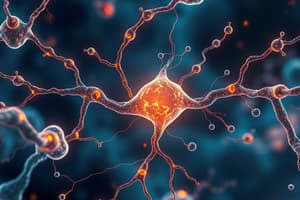Podcast
Questions and Answers
What is the chemical name for arachidonic acid?
What is the chemical name for arachidonic acid?
- 8,11,14-eicosatrienoic acid
- 5, 8, 11, 14-eicosatetraenoic acid (correct)
- Hexadecanoic acid
- 6,9-eicosadienoic acid
Where in the cell does arachidonic acid primarily originate?
Where in the cell does arachidonic acid primarily originate?
- Mitochondria
- Plasma membrane (correct)
- Endoplasmic reticulum
- Nucleus
What physiological stimuli can lead to the release of arachidonic acid from the plasma membrane?
What physiological stimuli can lead to the release of arachidonic acid from the plasma membrane?
- Skeletal muscle contraction
- Norepinephrine (correct)
- Increased oxygen levels
- Hypoglycemia
Which enzyme is activated in response to various stimuli, leading to the cleavage of arachidonic acid from membrane phospholipids?
Which enzyme is activated in response to various stimuli, leading to the cleavage of arachidonic acid from membrane phospholipids?
Which condition is primarily associated with the use of NSAIDs?
Which condition is primarily associated with the use of NSAIDs?
What are the two primary biochemical pathways arachidonic acid can enter?
What are the two primary biochemical pathways arachidonic acid can enter?
What is a consequence of aspirin's irreversible inhibition of COX-1?
What is a consequence of aspirin's irreversible inhibition of COX-1?
Which of the following drugs may have decreased clearance due to NSAID therapy?
Which of the following drugs may have decreased clearance due to NSAID therapy?
What role does COX-1 play in physiological functions?
What role does COX-1 play in physiological functions?
Why is aspirin considered an irreversible inhibitor of COX enzymes?
Why is aspirin considered an irreversible inhibitor of COX enzymes?
What dosage of aspirin is indicated for the primary prevention of myocardial infarction?
What dosage of aspirin is indicated for the primary prevention of myocardial infarction?
What is the primary result when arachidonic acid interacts with COX enzymes?
What is the primary result when arachidonic acid interacts with COX enzymes?
What is the primary acid-base disturbance caused by salicylic acid in aspirin therapy?
What is the primary acid-base disturbance caused by salicylic acid in aspirin therapy?
What unstable molecule is formed when arachidonic acid interacts with 5-LOX?
What unstable molecule is formed when arachidonic acid interacts with 5-LOX?
What is the end product when LTA4 interacts with LTA4 hydrolase?
What is the end product when LTA4 interacts with LTA4 hydrolase?
Which of the following leukotrienes contains cysteine?
Which of the following leukotrienes contains cysteine?
Which characteristic is NOT a defining feature of NSAID clinical necessity?
Which characteristic is NOT a defining feature of NSAID clinical necessity?
What is the mechanism by which inhibition of COX-1 leads to gastric toxicity?
What is the mechanism by which inhibition of COX-1 leads to gastric toxicity?
Which class of NSAIDs is more likely to lead to gastric injury?
Which class of NSAIDs is more likely to lead to gastric injury?
What effect do NSAIDs have on renal function by inhibiting COX?
What effect do NSAIDs have on renal function by inhibiting COX?
What is the characteristic of most NSAIDs that contributes to gastric toxicity?
What is the characteristic of most NSAIDs that contributes to gastric toxicity?
Which NSAID is highly selective for COX-2 and suitable for long-term treatment of chronic pain?
Which NSAID is highly selective for COX-2 and suitable for long-term treatment of chronic pain?
What is a significant concern related to the first-pass metabolism of diclofenac?
What is a significant concern related to the first-pass metabolism of diclofenac?
Which NSAID is an extremely potent COX-1 inhibitor often used in neonates for PDA closure?
Which NSAID is an extremely potent COX-1 inhibitor often used in neonates for PDA closure?
Which characteristic of ibuprofen makes it suitable for acute pain management?
Which characteristic of ibuprofen makes it suitable for acute pain management?
What is the effect of a lower IC50 value on an NSAID?
What is the effect of a lower IC50 value on an NSAID?
Which NSAID should be used with caution due to the risk of Steven-Johnson Syndrome (SJS) when combined with certain medications?
Which NSAID should be used with caution due to the risk of Steven-Johnson Syndrome (SJS) when combined with certain medications?
Nabumetone is activated to which compound in the liver?
Nabumetone is activated to which compound in the liver?
Which NSAID has a longer half-life allowing it to be used for chronic pain management?
Which NSAID has a longer half-life allowing it to be used for chronic pain management?
Flashcards
How do NSAIDs affect potassium levels?
How do NSAIDs affect potassium levels?
Nonsteroidal anti-inflammatory drugs (NSAIDs) can impair the renin-angiotensin-aldosterone system (RAAS) pathway, leading to decreased potassium excretion and increased potassium retention, resulting in hyperkalemia.
Why is aspirin an irreversible COX inhibitor?
Why is aspirin an irreversible COX inhibitor?
Acetylsalicylic acid, also known as aspirin, is an irreversible COX inhibitor. Its acetyl group forms a stable bond with COX enzymes, preventing their activity for the life of the platelet.
How does aspirin's selectivity for COX-1 affect its actions?
How does aspirin's selectivity for COX-1 affect its actions?
Aspirin's affinity for COX-1 is much higher than for COX-2. This means it preferentially inhibits COX-1, which plays a role in platelet aggregation and gastric mucosal protection.
Why can aspirin cause both respiratory alkalosis and AGMA?
Why can aspirin cause both respiratory alkalosis and AGMA?
Signup and view all the flashcards
Why should aspirin and ibuprofen not be used together?
Why should aspirin and ibuprofen not be used together?
Signup and view all the flashcards
Leukotriene Synthesis
Leukotriene Synthesis
Signup and view all the flashcards
5-HPETE
5-HPETE
Signup and view all the flashcards
LTA4
LTA4
Signup and view all the flashcards
LTB4
LTB4
Signup and view all the flashcards
Cysteinyl Leukotrienes
Cysteinyl Leukotrienes
Signup and view all the flashcards
Gastric Toxicity of NSAID's
Gastric Toxicity of NSAID's
Signup and view all the flashcards
Renal Toxicity of NSAID's
Renal Toxicity of NSAID's
Signup and view all the flashcards
NSAID's
NSAID's
Signup and view all the flashcards
What is the chemical name for arachidonic acid?
What is the chemical name for arachidonic acid?
Signup and view all the flashcards
Where in the cell does arachidonic acid originate?
Where in the cell does arachidonic acid originate?
Signup and view all the flashcards
What are the physiologic stimuli for the release of arachidonic acid from the plasma membrane?
What are the physiologic stimuli for the release of arachidonic acid from the plasma membrane?
Signup and view all the flashcards
What are the biochemical steps involved with the release of arachidonic acid from membrane phospholipids?
What are the biochemical steps involved with the release of arachidonic acid from membrane phospholipids?
Signup and view all the flashcards
What are the two possible biochemical pathways that arachidonic acid can enter?
What are the two possible biochemical pathways that arachidonic acid can enter?
Signup and view all the flashcards
What are the steps involved with the cyclo-oxygenase pathway?
What are the steps involved with the cyclo-oxygenase pathway?
Signup and view all the flashcards
What are the two COX isoforms, and how do they differ in terms of their physiology?
What are the two COX isoforms, and how do they differ in terms of their physiology?
Signup and view all the flashcards
Which NSAID serves as an irreversible inhibitor of COX enzymes?
Which NSAID serves as an irreversible inhibitor of COX enzymes?
Signup and view all the flashcards
Etodolac's Unique Property
Etodolac's Unique Property
Signup and view all the flashcards
Indomethacin's Potent COX-1 Inhibition
Indomethacin's Potent COX-1 Inhibition
Signup and view all the flashcards
Nabumetone's Activation and Dual Inhibition
Nabumetone's Activation and Dual Inhibition
Signup and view all the flashcards
Diclofenac's First-Pass Metabolism
Diclofenac's First-Pass Metabolism
Signup and view all the flashcards
Ibuprofen's Short Half-Life
Ibuprofen's Short Half-Life
Signup and view all the flashcards
Naproxen's Long Half-Life
Naproxen's Long Half-Life
Signup and view all the flashcards
Meloxicam and SJS Risk
Meloxicam and SJS Risk
Signup and view all the flashcards
Celecoxib's Specificity and Benefits
Celecoxib's Specificity and Benefits
Signup and view all the flashcards
Study Notes
Arachidonic Acid
- Arachidonic acid's chemical name is 5, 8, 11, 14-eicosatetraenoic acid.
- The numbers 5, 8, 11, and 14 correspond to the locations of double bonds within the molecule.
- Eicosa refers to 20 carbons.
- Arachidonic acid originates in the plasma membrane from lipid portions.
Physiologic Stimuli
- Physiologic stimuli trigger the release of arachidonic acid from the plasma membrane.
- These stimuli include vascular injury, inflammation (acute or chronic), norepinephrine, and infection.
Biochemical Steps
- Physiologic stimuli activate phospholipase A2 (PLA2).
- Calcium is required for PLA2 activation.
- PLA2 cleaves arachidonic acid from membrane phospholipids.
Biochemical Pathways
- Arachidonic acid can enter two biochemical pathways:
- Cyclooxygenase (COX) pathway.
- Lipoxygenase (LOX) pathway.
COX Pathway
- Arachidonic acid interacts with cyclooxygenase (COX).
- This interaction forms an unstable intermediate called prostaglandin G2 (PGG2).
- PGG2 reacts with COX to form prostaglandin H2 (PGH2).
- PGH2 is a more stable product.
COX-1 and COX-2
- Two COX isoforms exist.
- COX-1 is a "housekeeping" enzyme, constantly active, and involved in protective functions like gastric protection.
- Increased bicarbonate production in the stomach results from the activation of PGE1.
- COX-2 is inducible—expressed only in response to tissue damage or infection.
LOX Pathway
- 5-LOX is a key enzyme.
- Arachidonic acid reacts with 5-LOX
- Products include LTA4, LTB4, LTC4, LTD4, and LTE4.
- These are known as cysteinyl leukotrienes; they generally contain cysteine amino acid.
Defining Characteristics of NSAIDs
- Renal function
- Gastrointestinal integrity
- Pharmacokinetics (half-life, bioavailability)
- Plasma protein binding (albumin)
- Drug-drug interactions (especially with cytochrome P450 enzymes)
- Elimination (hepatic function)
Gastric Toxicity
- COX-1 inhibition decreases PGE1 production.
- Decreased PGE1 leads to decreased mucus production and decreased bicarbonate intravasation.
Renal Toxicity
- NSAIDs can inhibit COX, decreasing prostacyclin (PGI2) production.
- Decreased vasodilation, increased vasoconstriction of afferent and efferent renal arterioles occurs.
- Reduced glomerular filtration rate (GFR) occurs.
Other Drug Interactions
- NSAIDs can affect the clearance of other drugs (e.g., lithium).
- Some NSAIDs lower potassium excretion, increasing serum potassium levels (hyperkalemia).
NSAID Indications
- Primarily used for pain relief (analgesia).
- Can be used to prevent myocardial infarction (MI) and stroke.
Respiratory Alkalosis
- Aspirin can cause respiratory alkalosis.
- Salicylic acid is acidic.
- The brain increases respiratory rate, leading to CO2 expiration.
- Reduced CO2 in the bloodstream increases blood pH, causing respiratory alkalosis.
Studying That Suits You
Use AI to generate personalized quizzes and flashcards to suit your learning preferences.




